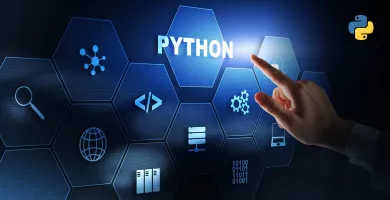
Top 25 Agile and Scrum Interview Questions and Answers
Oct 10, 2025 6 Min Read 1337 Views
(Last Updated)
Are you a team player? Then you should be comfortable in using Agile and Scrum methodologies in your day to day life. Not sure what questions to expect in an Interview? We got you covered!
This blog covers top 25 agile and scrum interview questions and answers ranging from beginner to expert level concepts. Let’s get started!
Table of contents
- Important Concepts for Interview
- Top 25 Agile and Scrum Interview Questions and Answers
- Beginner Level
- Intermediate Level
- Expert Level
- Scenario Questions
- Conclusion
- FAQs
- Q1.What is an Agile practitioner?
- Q2. How long does it take to master Agile?
- Q3. Is any certification needed for Agile?
Important Concepts for Interview
Agile is a project management methodology that emphasizes adaptability and collaboration to deliver projects flexibly and responsively. This section covers the important agile and scrum concepts that you should know before taking an actual interview. Let’s dig deep into it.
- Agile Manifesto: It talks about individual values, interactions, customer collaboration and responding to change.
- Key principles of Agile: These principles are about delivering working software frequently and embracing new changes to the project.
- Other Project Development Methods: Knowing about different project methodologies and how agile differs from others will boost your understanding in project management.
- Agile Frameworks: It includes different frameworks such as scrum, kanban, SAFe, XP, Lean and Crystal and how it is suitable in different occasions.
- Roles in Scrum: It is helpful in assigning roles and responsibilities for each team member for smoother development.
- Scrum Artifacts: It is helpful in keeping track of the project in every scrum meeting to evaluate the progress of the project.
- Scrum Events: It is helpful in planning, coordinating, and conducting meetings to discuss and evaluate the work with their team members.
Ready to start with project management and Agile methodology? Enroll in HCL Guvi’s course on Introduction to Agile and Project Management. It provides a detailed overview of project management and how agile plays a major role in it. You can also get an industry-recognized certification by completing this course to showcase in your resume.
Top 25 Agile and Scrum Interview Questions and Answers
In this section, we will look into 25 agile and scrum interview questions and answers. It covers all the important concepts mentioned above. Let’s get started!
Beginner Level
- What do you mean by Agile methodology or Agile process?
Agile methodology is an iterative and incremental approach for project management. It is helpful in quickly delivering value and responding to changing requirements. There are six phases in Agile process which includes:
- Requirement Gathering: This phase involves gathering requirements that are necessary for building a project.
- Design: In this phase, the designers create a prototype based on the user requirements using tools like Figma.
- Development: The next phase is the design phase, the developers start to convert the designs into code using various development tools.
- Testing: Once the development is complete, the testers will test the code under various critical conditions.
- Deployment: When the testers give a positive result, the developers start to deploy the code in various platforms such as AWS, GCP and others.
- Feedback: Once the deployment is complete, the user and stakeholders review the project and provide feedback for further improvements.
Ready to learn Agile? Start your journey towards Agile by enrolling in HCL Guvi’s course on Agile Fundamentals. This course provides a detailed overview of agile methodologies, scrum meetings and why company’s favorite is agile. It also provides an industry recognized certification.
- What is a daily stand-up meeting?
A stand-up meeting is a brief and regular meeting that happens daily for 15 minutes. Team mates who are working on the same project discuss their progress, plan of the day and identify any obstacles.
- What are the advantages and disadvantages of Agile?
| Advantages | Disadvantages |
| It ensures the final product meets customer needs more accurately | It is difficult to predict the costs, timelines and deliverables in advance |
| It allows teams to adapt to evolving business needs | It is not ideal for fixed scope and budget |
| It delivers working software in short cycles | It requires a skilled and self-organizing team |
| Feedback loops help in identifying and mitigate risks early in the project. | It demands customer input which may not always be possible |
- What is the difference between agile and waterfall?
| Agile | Waterfall |
| It is an iterative and incremental approach | It is a linear and sequential approach |
| It is highly flexible for new changes | It is rigid and changes are difficult to implement |
| Customer involvement is continuous throughout the project | Customer involvement is only at the beginning and end |
| It delivers frequent small releases | It delivers one final release at the end |
- What is Scrum?
Scrum is the most famous agile framework used for developing, delivering and sustaining complex products. It is lightweight and simple to understand. The key components of scrum includes:
- Scrum Roles: It defines roles and responsibilities to the individual
- Scrum Artifacts: It defines the documents and artifacts required for scrum
- Scrum Events: These are the events to discuss the collaborative work progress
- What is a sprint?
A sprint is a fixed length of time period iteration in Scrum which lasts up to 4 weeks. After each sprint, a specific set of product features is developed and delivered. The sprints are goal oriented. During the sprint, team members maintain review and retrospection to track individual progress.
- What is the use of a Burn down chart?
A Burn down chart is a visual management tool used in Agile development and Scrum to track the progress of a sprint or the project. The X-axis of the chart shows the timeline, which is sprint days and the Y-axis of the chart represents remaining work, i.e., remaining tasks. It is helpful in early detecting the potential delays and bottlenecks.
Explore: Top 10 Backend Web Development Frameworks In 2025
Intermediate Level
- What is the difference between sprint and product backlog?
| Sprint Backlog | Product Backlog |
| It is a list of tasks and user stories selected from product backlog to be completed in a sprint | The owner of the sprint backlog is Scrum team |
| The owner of the sprint backlog is the Scrum team | The owner of the product backlog is a product owner |
| It only covers the ongoing sprint | It covers the entire project |
| It is frozen during and after the sprint | It is continuously evolving and reprioritized |
- What is an agile manifesto?
The Agile Manifesto is a declaration of core values and principles for Agile methodology. This was created in 2001 by 17 software developers to improve software development lifecycle by focusing on collaboration, flexibility and customer involvement.. The four key values of Agile Manifesto includes:
- It values individuals and their interactions over processes and tools
- It prioritizes working software over comprehensive documentation
- It includes customer collaboration with the project over contract negotiations
- It focuses on responding to change by following a plan
- What are the 12 principles of the agile manifesto?
The 12 principles of the agile manifesto include:
- Customer satisfaction through early and continuous delivery of valuable software.
- Welcome changing requirements, even late in development.
- Deliver working software frequently, from a couple of weeks to a couple of months.
- Business people and developers must work together daily.
- Build projects around motivated individuals and give them the support they need.
- Use face-to-face conversation as the most effective method of communication.
- Working software is the primary measure of progress.
- Agile processes promote sustainable development.
- Continuous attention to technical excellence and good design enhances agility.
- Simplicity is the art of maximizing the amount of work not done is essential.
- The best architectures, requirements, and designs emerge from self-organizing teams.
- Regularly, the team reflects on how to become more effective and adjusts accordingly.
- What is Agile Testing?
The fourth phase in Agile project management is testing. It is a software testing practice that follows the principles of agile development. It is continuous and collaborative testing throughout the development cycle. It focuses on early, continuous and automated testing, team involvement and adaptability.
- Explain the roles in scrum
There are three main roles in Scrum:
- Product Owner: He/She owns the product backlog, sets the vision and prioritizes features, represents customer interests, and makes decisions about scope and requirements.
- Scrum Master: They organize the scrum events and ensure the team follows scrum practices, shields the team from distractions, and coaches the team in continuous improvement.
- Development Team: It is a cross-functional group that builds the product, self organizes, collaborates with each other and is responsible for delivering the product on time.
- What are the differences between sprint planning, sprint review and sprint retrospective meeting?
| Sprint Planning | Sprint Review | Sprint Retrospective |
| It defines what will be done in the sprint | The participants include Scrum Team consists of product owner, scrum master and development team | It reflects on and improves the process |
| It is conducted at the start of the sprint | It is conducted at the end of the sprint | It is conducted after the sprint review |
| The participants include Scrum team and stakeholders | The participants includes Scrum team and stakeholders | The participants includes scrum team only |
- What are the differences between agile and scrum?
| Agile | Scrum |
| It consists of set of phases for software development | It is a specific agile framework with defined roles and events |
| It is flexible in choosing practices | It is prescriptive and well structured |
| It chooses development over documentation | It provides defined roles, artifacts and ceremonies |
| It is a general approach for the entire project | It is a well defined process within the agile for specific product feature |
- Who is a scrum master and explains their responsibilities?
A scrum master is a facilitator in a Scrum Team. They ensure that the team adheres to Scrum practices, helps the team in improving, and removes any obstacles to the progress of the project. Their responsibilities include
- They coach the team about Scrum principles and practices
- Facilitates the scrum events such as daily stand-ups, sprint planning, reviews and retrospectives
- They remove impediments that block the team’s progress
- They ensure the collaboration between the scrum roles
Expert Level
- What is Scrum of Scrums (SoS)?
In Agile methodology, Scrum of Scrums (SoS) is a technique to scale the Scrum to multiple teams, facilitating communication and coordination between them. It includes the scrum master from every team communicating with each other regularly to discuss the progress. The main purpose of SoS is to cross-team coordination and synchronize efforts between different scrum teams working on a big project. It is usually held daily or a few times per week depending on the project size and complexity.
- Explain iterative and incremental development in Agile
Agile development uses a combination of iterative and incremental approaches.
The incremental approach builds the product piece by piece, each increment adds functionality to the existing product. Examples include the first release maybe a login feature and the next release adds user dashboard etc.
The interactive approach refined through repeated iterations, each iteration allows improvements, refinements and feedback application. Examples: Improve user interface in interaction 2 based on user feedback from iteration 1.
- What is Kanban?
Kanban is an Agile framework that focuses on visualizing work, limiting work in progress, and improving flow efficiency. It uses a kanban board, which is a visual representation board divided into columns like To do, In progress, Testing, and Done. Based on the stage of the task, it will be moved to any of the columns in the kanban board for easy tracking of the progress. It helps identify bottlenecks and is flexible for planning and prioritizing.
- Mention some of the Agile metrics
Agile methodology uses various metrics to track the performance and quality of the work. The key metrics include:
- Velocity: It measures the quantity of work a team completes in a sprint
- Burndown chart: It shows the remaining work over time in a sprint
- Burnup Chart: It shows the completed work over time toward the project goal
- Cycle Time: It measures the time taken to complete a task after the work starts
- Defect Density: It measures the number of bugs per unit of code or feature
- How long does the scrum cycle last?
In general, the scrum cycle refers to the duration of the sprint. The sprint typically lasts up to 4 weeks. The duration is fixed throughout the project and irrespective of the number of sprints. At the end of each sprint, the team delivers a potentially shippable product increment. Each cycle includes sprint planning, daily stand-ups, sprint review, and sprint retrospective.
- What is DoD?
DoD stands for Definition of Done. It is a shared understanding of what it means to be considered as completed. It ensures consistency, quality across all the deliverables and prevents incomplete or partially done work from being completed. It usually refers to code that is written and reviewed, functionality is tested, code is deployed, or documentation is updated.
Scenario Questions
- The Product Owner asks you to include a critical feature mid-sprint. How do you respond?
In Scrum, the scope of a sprint is locked once the sprint starts. This helps the team stay focused and deliver what was committed. I would politely remind the Product Owner of this principle. If the new feature is critical, I would suggest either adding it to the Product Backlog and prioritizing it for the next sprint, or if it’s truly urgent, we can discuss ending the current sprint early, which is rare and must involve the entire team’s agreement.
- Your team was unable to complete the committed stories in the sprint. What do you do during the Sprint Review and Retrospective?
During the Sprint Review, we are transparent with stakeholders and the scrum master. We communicate what was completed and what wasn’t, and why. The focus should be on the value delivered, even if some stories were incomplete. Unfinished stories return to the Product Backlog for re-prioritization.
- Your daily stand-ups are turning into long status meetings with side conversations. What would you do?
Daily stand-ups are meant to be short, i.e., up to 15 minutes, and focused on yesterday’s work progress, today’s schedule, and blockers. If side discussions begin, I’d gently intervene and suggest taking them ‘offline’ after the meeting. I might say something like ‘Let’s park this for now and continue right after the stand-up so we stay on track.’
- A stakeholder insists on delivering a feature without full testing to meet a deadline. What do you do?
While I understand the pressure to meet deadlines, I would strongly advocate for the importance of product quality and risk mitigation. Delivering untested code can lead to production defects, loss of trust, or higher costs later. I would explain the risks of bypassing testing and suggest alternatives, like delivering an MVP version that’s properly tested or delivering in phases, with critical tests completed in the first.
Conclusion
In conclusion, this blog is the perfect last-minute guide to ace your Agile and Scrum interview. It covers Agile topics ranging from the Agile Manifesto, key principles, agile frameworks, and Scrum topics, including Scrum roles, Scrum artifacts, and Scrum events. Mastering these concepts will not only help you in acing project management roles interviews but also help you in your daily life to connect with your teammates for collaborative development. Happy Learning!
FAQs
Q1.What is an Agile practitioner?
An Agile practitioner is someone who is highly skilled in Agile techniques. They have an Agile mindset, meaning they embrace new opportunities and adapt easily to change.
Q2. How long does it take to master Agile?
With proper guidance and bootcamp courses, you can master Agile in a few months.
Q3. Is any certification needed for Agile?
No certification is required, but popular ones like CSM, PSM, or PMI-ACP can enhance your knowledge and credibility.




































Did you enjoy this article?